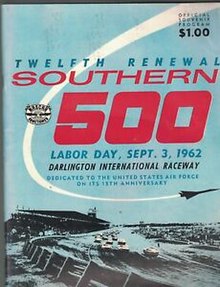|
1962 Southern 500
The 1962 Southern 500, the 13th running of the event, was a NASCAR Grand National Series event that was held on September 3, 1962, at Darlington Raceway in Darlington, South Carolina. The transition to purpose-built racecars began in the early 1960s and occurred gradually over that decade. Changes made to the sport by the late 1960s brought an end to the "strictly stock" vehicles of the 1950s. Ralph Earnhardt drove the #47 car for Jack Smith. The car had "Jack" written on the roof, but Earnhardt drove the race and was involved in a spin entering turn one. BackgroundDarlington Raceway, nicknamed by many NASCAR fans and drivers as "The Lady in Black" or "The Track Too Tough to Tame" and advertised as a "NASCAR Tradition", is a race track built for NASCAR racing located near Darlington, South Carolina. It is of a unique, somewhat egg-shaped design, an oval with the ends of very different configurations, a condition which supposedly arose from the proximity of one end of the track to a minnow pond the owner refused to relocate. This situation makes it very challenging for the crews to set up their cars' handling in a way that will be effective at both ends. The track is a four-turn 1.366 miles (2.198 km) oval.[3] The track's first two turns are banked at twenty-five degrees, while the final two turns are banked two degrees lower at twenty-three degrees.[3] The front stretch (the location of the finish line) and the back stretch is banked at six degrees.[3] Darlington Raceway can seat up to 60,000 people.[3] Darlington has something of a legendary quality among drivers and older fans; this is probably due to its long track length relative to other NASCAR speedways of its era and hence the first venue where many of them became cognizant of the truly high speeds that stock cars could achieve on a long track. The track allegedly earned the moniker The Lady in Black because the night before the race the track maintenance crew would cover the entire track with fresh asphalt sealant, in the early years of the speedway, thus making the racing surface dark black. Darlington is also known as "The Track Too Tough to Tame" because drivers can run lap after lap without a problem and then bounce off of the wall the following lap. Racers will frequently explain that they have to race the racetrack, not their competition. Drivers hitting the wall are considered to have received their "Darlington Stripe" thanks to the missing paint on the right side of the car. Race reportIt took four hours and fourteen minutes to complete 364 laps.[2] Sixty thousand people would watch Larry Frank defeat Junior Johnson[4] by five seconds; acquiring his only win in the Cup Series.[2] Joyce Brown was Miss Southern 500 for that year.[5] Gary Sain would make his entrance into NASCAR racing at this race while Roscoe Thompson would retire from NASCAR after racing here.[6] Pontiac vehicles were the preferred manufacturer for this race; especially the 1962 Catalina model.[2] There was a high percentage of then-recent model cars in this race; with only one vehicle with a model year of 1960.[2] During the race, Richard Petty had to drive his vehicle to pit road with only three properly working tires. The race had just passed the halfway mark when Bobby Johns (#72) blew a tire between Turns 3 & 4, ricocheted off the guardrail and caught the oncoming Darel Dieringer (#26).[2] Dieringer's gas tank ruptured and caught fire as the driver fought for control and Bunkie Blackburn (#41) got into the rail to miss the trouble. The car finally stopped and the dazed Dieringer climbed out. Matt DeMatthews was the last-place finisher after oil pressure issues forced his 1961 Ford Galaxie out of the race.[2] Fireball Roberts earned the pole position with a speed of 130.246 miles per hour (209.611 km/h) but would finish the race in 36th (out of 44 cars) after crashing on lap 74. Larry Frank's winning speed would be 117.965 miles per hour (189.846 km/h).[2] Johnny Allen had an awful crash[2] but left the race without any injury. Due to a scoring error, Junior Johnson was originally flagged as the winner of this race. Johnson went to victory lane; planning to expand his chicken farm with the money he earned from the race. NASCAR officials managed to catch this error and made Larry Frank the winner instead. Notable crew chiefs recorded as participating in the event included Shorty Johns, Ratus Walters, Lee Petty, Banjo Matthews, Glen Wood and Herman Beam.[7] Race earnings for each driver ranged from the winner's share of $21,730 ($218,878 when adjusted for inflation) to the last-place share of $400 ($4,029 when adjusted for inflation). The total purse for this event was $71,865 ($723,868 when adjusted for inflation).[8] While a kinescope was responsible for filming this race to an audience that could not see it live, ABC's Wide World of Sports kept a copy of this race on VHS. For superstition reasons from NASCAR driver Joe Weatherly, this race is historically known as the 12th Revival of the Southern 500 instead of the 13th Southern 500. He would collide with David Pearson although they would go on to finish the race. Qualifying
Top 10 finishers
TimelineSection reference: [2]
References
|
||||||||||||||||||||||||||||||||||||||||||||||||||||||||||||||||||||||||||||||||||||||||||||||||||||||||||||||||||||||||||||||||||||||||||||||||||||||||||||||||||||||||||||||||||||||||||||||||||||||||||||||||||||||||||||||||||||||||||||||||||||||
Portal di Ensiklopedia Dunia
